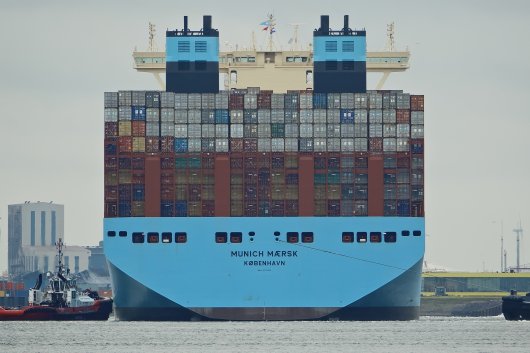Maersk spent 50% more on bunkers in 2018 as average price jumped $103
Fuel consumption rose by 1.5m tonnes last year.
A.P. Moller - Maersk reports that its Ocean segment spent $1.7bn more on bunker fuel in 2018 compared to the previous year.
The boxship giant's total annual spend on marine fuels climbed 50.9 percent to $5.042bn last year, up from $3.341bn in 2017.
The average bunker price paid by Ocean in 2018 was $424 per tonne - a rise of $103, or 32.1 percent, on the $321-per-tonne figure recorded in 2017. It is the highest annual average price since 2014.
In terms of bunker consumption, Ocean purchased 11.894m tonnes of marine fuel last year, representing a year-on-year (YoY) increase of 1.499m tonnes, or 14.4 percent.
Quarterly breakdown
Maersk: Average fuel prices since 2012
Key financial results for 2018
In its financial results for the year, Ocean reported a profit before interest, tax, depreciation, amortization and impairment losses (EBITDA) of $3.007bn, which was a YoY improvement of $230m, or 8.3 percent.
Revenue during the 12-month period rose by 6.343bn, or 28.8 percent, to $28.366bn.
A.P. Moller - Maersk Group posted an underlying profit of $220m - a decline of $136m, or 38.2 percent, on the previous year's result.
Guidance for 2019
In its guidance for 2019, Maersk said a $100 change in the price of bunker fuel would lead to the group's EBITDA varying by $0.6bn.
The boxship giant's total annual spend on marine fuels climbed 50.9 percent to $5.042bn last year, up from $3.341bn in 2017.
The average bunker price paid by Ocean in 2018 was $424 per tonne - a rise of $103, or 32.1 percent, on the $321-per-tonne figure recorded in 2017. It is the highest annual average price since 2014.
In terms of bunker consumption, Ocean purchased 11.894m tonnes of marine fuel last year, representing a year-on-year (YoY) increase of 1.499m tonnes, or 14.4 percent.
Quarterly breakdown
| Q1 | Q2 | Q3 | Q4 | |
| Consumption (MMT) | 3.129 | 3.002 | 2.915 | 2.848 |
| Cost ($bn) | 1.194 | 1.205 | 1.318 | 1.325 |
| Avg Price ($/mt) | 382 | 401 | 452 | 465 |
Maersk: Average fuel prices since 2012
| Year | Price($/mt) | +/-($) | +/-(%) |
| 2018 | 424 | +103 | +32.1 |
| 2017 | 321 | +98 | +43.9 |
| 2016 | 223 | -92 | -29.2 |
| 2015 | 315 | -247 | -44.0 |
| 2014 | 562 | -33 | -5.5 |
| 2013 | 595 | -66 | -10.0 |
| 2012 | 661 | -- | -- |
Key financial results for 2018
In its financial results for the year, Ocean reported a profit before interest, tax, depreciation, amortization and impairment losses (EBITDA) of $3.007bn, which was a YoY improvement of $230m, or 8.3 percent.
Revenue during the 12-month period rose by 6.343bn, or 28.8 percent, to $28.366bn.
A.P. Moller - Maersk Group posted an underlying profit of $220m - a decline of $136m, or 38.2 percent, on the previous year's result.
Guidance for 2019
In its guidance for 2019, Maersk said a $100 change in the price of bunker fuel would lead to the group's EBITDA varying by $0.6bn.

|
Swedish biomethane bunkered in Gothenburg
Test delivery performed by St1 and St1 Biokraft, who aim to become large-scale suppliers. |
|
|
|
||

|
Cockett to be closed down after 45 years
End of an era as shareholders make decision based on 'non-core nature' of Cockett's business. |
|
|
|
||

|
Petrobras confirms prompt availability of VLS B24 at Rio Grande
Lead time for barge deliveries currently five days. |
|
|
|
||

|
IMO approves pricing mechanism based on GHG intensity thresholds
Charges to be levied on ships that do not meet yearly GHG fuel intensity reduction targets. |
|
|
|
||

|
VARO Energy expands renewable portfolio with Preem acquisition
All-cash transaction expected to complete in the latter half of 2025. |
|
|
|
||

|
NYK trials biofuel in milestone coal carrier test
Vessel is used to test biofuel for domestic utility company. |
|
|
|
||

|
H-Line Shipping orders LNG bunkering vessel
Vessel with 18,000-cbm capacity to run on both LNG and MDO. |
|
|
|
||

|
How to engineer and manage green shipping fuels | Stanley George, VPS
Effective management strategies and insights for evolving fuel use. |
|
|
|
||

|
Swedish government bans scrubber wastewater discharges
Discharges from open-loop scrubbers to be prohibited in Swedish waters from July 2025. |
|
|
|
||

|
MAN Energy Solutions achieves 100% load milestone for ammonia engine
Latest tests validate fuel injection system throughout the entire load curve. |
|
|
|
||

